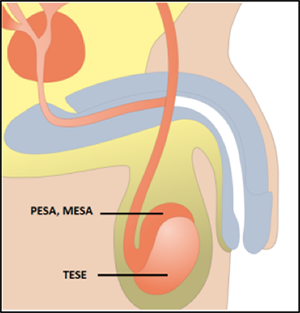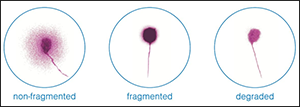No Sperms
Treatments
- ICSI
- TESA / MESA / PESA / TESE
- Sperm DNA Fragmentation
- Donor Program
- Fertility Booster Diet
- Weight Loss Management
ICSI
What is it?
It is a laboratory procedure where a single sperm is picked up with a fine glass needle and is injected directly into the egg. This is carried out in the laboratory by experienced embryologists using special equipment.
When is it recommended?
It is recommended in any or more of the following conditions.
- When the sperm count is very low
- When the sperm cannot move properly or are in other ways abnormal
- When sperm has been retrieved surgically from the epididymis (MESA/PESA) or the testes
- (TESE/TESA), from urine or following electro-ejaculation
- When there are high levels of antibodies in the semen
- When there has been a previous fertilisation failure using conventional IVF.
What are the advantages?
 Very few sperms are required for the process and the ability of the sperm to penetrate the egg is no longer important as this has been assisted by the ICSI technique. ICSI does not guarantee that fertilisation will occur as the normal cellular events like fusion of nuclei still need to occur once the sperm has been placed in the egg.
Very few sperms are required for the process and the ability of the sperm to penetrate the egg is no longer important as this has been assisted by the ICSI technique. ICSI does not guarantee that fertilisation will occur as the normal cellular events like fusion of nuclei still need to occur once the sperm has been placed in the egg.
TESA / MESA / PESA / TESE
Testicular Sperm Aspiration / Micro Epididymal Sperm Aspiration / Percutaneous Epididymal Sperm Aspiration / Testicular Sperm Extraction
What is it?
It is a method of drawing sperms directly from Testis or Epididymis with a syringe and needle or by a surgical procedure.
When is it recommended?
When the ejaculate does not contain vital sperms one of these methods is recommended.
How is it performed?
 PESA AND MESA involve extraction of sperms from Epididymis (a tubular extension of testis). This is done when the Vas Deferens (duct that carries sperms away from testis for being ejaculated) is impaired. In the event of the PESA method the sperms are aspirated together with the fluid from epididymal ducts with a fine needle directly through the skin of scrotum. In MESA method a small microsurgical skin incision is performed, a puncture needle is inserted via this incision and the fluid is aspirated. The fluid is immediately analyzed in an embryology laboratory.
PESA AND MESA involve extraction of sperms from Epididymis (a tubular extension of testis). This is done when the Vas Deferens (duct that carries sperms away from testis for being ejaculated) is impaired. In the event of the PESA method the sperms are aspirated together with the fluid from epididymal ducts with a fine needle directly through the skin of scrotum. In MESA method a small microsurgical skin incision is performed, a puncture needle is inserted via this incision and the fluid is aspirated. The fluid is immediately analyzed in an embryology laboratory.
TESE
If sperms can not be obtained by MESA method, TESE is performed. In TESE, sperms are obtained directly from the testicular germinal epithelium. Tissue samples are taken from small incisions in the outer testicular layer and are analysed in the embryology laboratory to confirm presence of sperms in the aspirated fluid.
What are the advantages?
- The procedures are performed on the outpatient basis in a short general anesthesia.
- The procedure can be planned for the same day as the oocyte pickup from the female partner.
- The obtained fresh sperms are immediately used for oocyte fertilization with the IVF or ICSI
- The spare tissue is cryopreserved to avoid the need to repeat the procedure.
Sperm DNA Fragmentation
What is it?
It is a test performed with fresh ejaculate received from the patient. This is an effective method for measuring DNA damage in thousands of sperm in the ejaculate. It measures the susceptibility of sperm DNA to denaturation process such as exposure to heat or acids. After this exposure sperms are stained with a fluorescent probe (dye) that interacts with the DNA molecule. Then quantitative analysis made about sperms with fragmented DNA.
How is it done?

- Freshly collected ejaculate is subjected to treatment with certain agents like acids or heat.
- The sample is then stained appropriately and observed under microscope to find out the proportion of sperms with fragmented and non-fragmented DNA.
- On the basis of this proportion suitability of the semen sample for IVF, ICSI or IMSI can be decided.
How can it be treated?
- Damage caused to sperms by oxidative stress can be treated with change in lifestyle and appropriate diet for avoiding oxidative stress.
- If the damage is due to infection, treatment of infection with antibiotics can be beneficial in reducing sperm DNA damage.
- Varicocoele is one of the commonly known causes of male infertility and it is associated with sperm DNA damage. Treating varicocoele can improve sperm DNA integrity.
- Generally DNA damage occurs at the post-testicular (i.e. in the ejaculate) level and testicular sperms are likely to have healthier DNA integrity than ejaculated sperms. ICSI may be an effective treatment than IVF for sperm with high DNA fragmentation.
Donor Program
What is it?
When the patient couples have problems in conceiving and if the problem is found in the quality / quantity of germ cells (Gametes), oocytes or spermatozoa or embryos are collected from suitable donor and used for ART.
When is it recommended?
It is recommended in following situations.
- If the female partner is not able to produce oocytes suitable for fertilization, oocytes can be received from a suitable (depending on blood group and other body features) donor female.
- If semen sample of the male partner does not contain any sperms (Azoospermea) or adequate number of sperms (Oligospermia) or properly motile sperms (Asthanospermea) or morphologically abnormal (Teratospermea), sperms are received from a suitable donor male.
- If gametes from both the partners are not suitable for fertilization and further implantation, preformed embryos formed by fusion of gametes from appropriate male and female donor are taken used for ART.
How is it done?
- When oocyte donation program is to be conducted, the healthy donor female is contacted and is given suitable hormone therapy for release for oocytes. These eggs can be used for IVF and then can be transferred into uterus of recipient who is also on hormone therapy.
- In sperm donor program, healthy and suitable male is contacted and his semen sample is collected on the same day when IVF is to be performed. The eggs collected from female partner are fertilized in vitro and used for fertilizing the oocytes.
- For embryo donation program, oocytes from suitable healthy female (who is on hormone therapy) are collected. On the same day, semen is also collected either from the concerned male partner or donor and is used for IVF. After fertilization, the embryo development is allowed to proceed for three or five days depending upon hormonal status of the recipient. The embryo in 8 cell stage or Blastocyst stage is used for transfer into recipient female’s uterus.
Fertility Booster Diet
Intake of proper food becomes very important during the fertility treatment. Eating certain foods during different phases of your menstrual cycle can enhance the fertility. So, if a woman wants to maximize her chances of conceiving, it is possible to eat foods that have advantageous to each phase. So, we ask our experts to weigh in on what to actually eat during each of the reproductive phase.
The list includes:
1. Plenty of fruits and vegetables
2. Complex carbohydrates – whole grains like brown rice , oats and whole meal bread .
3. Organic food where possible.
4. Oily foods like nuts, fish and oil.
5. Add lemon , pomegranate, green leafy vegetables and tomatoes to diet .
6. Flax seeds + sunflower seeds .
7. Avoid trans fats.
8. Increase intake of fibre.
9. More fish and organic eggs than red meat .
10. Avoid additive ,preservatives and artificial sweetner.
11. Reduce and avoid sugar both on its own and hidden in food .
12. Avoid caffeine : coffee, chocolate ,tea ,cola & alcohol .
13. Avoid processed food.
14. Try having fresh and home-made food.
Weight Loss Management
What is it?
It is avoiding weight gain or losing weight for improving the chances of conceiving. Too low or too high body weight can interfere with fertility of an individual and hence, needs to be managed appropriately.
How is it done?
Normally, weight loss management involved diet and exercise. The couple trying for pregnancy needs to take careful measures in this. Proper diet and moderate exercise are best recommended for weight loss. But during pregnancy if necessary, weight management must be done preferably by diet control. Heavy exercise can affect the embryonic development in uterus and hence, has to be avoided.
When is it recommended?
Excess body weight in female partner is known to reduce the possibility or pregnancy. There is a need to manage the weight appropriately for natural pregnancy or even IVF. When an obese patient approaches for IVF treatment, before treatment the patient needs to undergo weight management regime and only then the IVF protocol can be followed. As mentioned above, the weight loss should be by controlled diet and not entirely by exercise.
